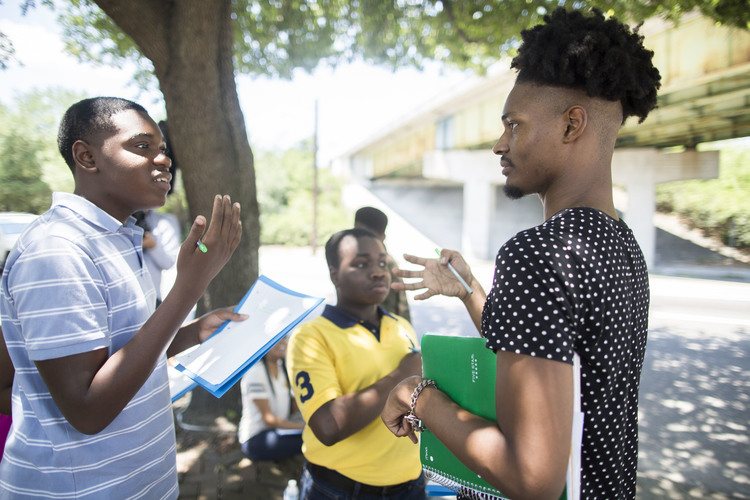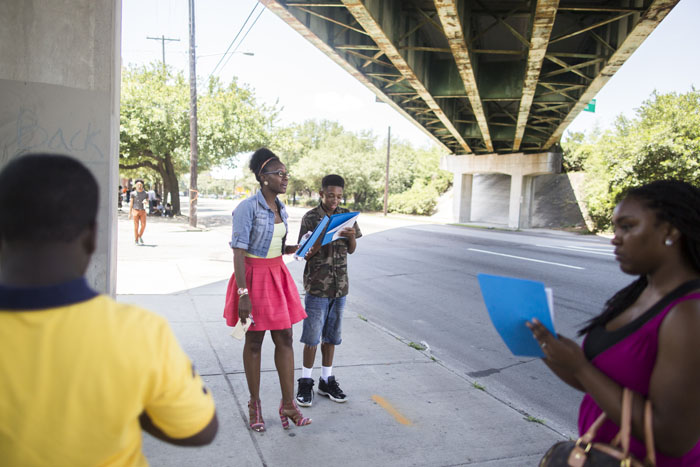
Investigating the history of Savannah’s I-16 flyover
For eight months now, Block by Block youth and teaching-writers have been continually investigating the stories and landscape of Savannah’s West Side. Together they are determining how history has shaped the present, how personal narratives—both visible and invisible—are the fibers that bind social narratives, and how structural inequities are made manifest on the street corner, in their schools, and—on this particular day—in the boardrooms of urban planners and developers.
On a Saturday in June, Block by Block educators and youth partnered with the Savannah Development and Renewal Authority to facilitate a very special Block by Block workshop that focused on the past, present, and future of a specific block on Savannah’s West Side.
The block of focus was Martin Luther King Jr. Blvd and W. Wayne Street, at the exact spot where MLK Blvd is bisected by a flyover from Interstate 16 and just a half block from the Civil Rights Museum, where Block by Block youth meet every week. The I-16 flyover, built in the 1970s, severs MLK Blvd in two, and, at the time it was built, it separated a once-thriving African-American arts and small business district from the more affluent and white downtown shopping district.
It was also a special day because, once again, Block by Block was an intergenerational writing and research space.
Deep brings together youth, families, historians, artists, urban planners, and community leaders.
Block by Block youth, family members, community leaders, artists, urban design experts, and Civil Rights Museum staff came together to research the block, share knowledge, and envision what the block might look like if artists and community leaders were allowed to respond creatively to the structure—or tear it down altogether.
The group began the day writing and sharing about their history and experience with the West Side.
Then they walked around the block and wrote down their observations—what did they see, hear, and smell? How did they feel when they crossed the street? How loud were the cars passing? Was it safe to ride a bike?
What kind of community space has the flyover created or taken away?
Sam and his mom writing down observations about the flyover
Upon returning, people wrote about what they observed then shared their observations.
- One person noted that the boulevard had a kind of “dead spot” in it where the flyover covered the block. It was unpleasant to walk along this 100-yard stretch because it wasn’t designed for pedestrians.
- Several noted the that, though the site was in general not welcoming for pedestrians, it gave cover and sanctuary to a small population of homeless who lived at the top of the embankment, just below the underside of the roadway.
- One participant noted that the I-16 flyover in many ways reflects how Interstate highways across the country were used to raze low-income neighborhoods and displace their residents, usually families of color.
- Another participant, who brought with her a wealth of knowledge about the history of MLK Jr. Blvd, talked about how the building of the flyover was the culmination of the once-vibrant street’s downfall. The beginning of the downfall was the demolition of Savannah’s Union Station—the train station that until 1963 sat just two blocks north of the block where the flyover now stands. The train station ensured that regional visitors to Savannah spilled out onto what was then called West Broad Street and helped local businesses thrive. The station was torn down to make room for the I-16 highway.
- And most people in the room agreed that the flyover was an eye sore and was generally unwelcoming.
Then people wrote about what they might do with the block if they were given the power to tear the I-16 flyover down or, at least, respond creatively to it so that it might bring beauty to the neighborhood.
The group shared some inventive ideas that spoke to the need to develop inviting public spaces and build community infrastructure in the neighborhood, including:
- A multi-tiered modular public space, brightly painted, where local residents, vendors, and food trucks sell their products.
- A building housing civic spaces and offices where community organizations like Deep could have free office space and shared space to foster collaboration.
- A playground.
- An elevated park and public garden, much like New York City’s High Line.
Block by Block youth and other participants left the workshop excited about how much they collectively uncovered about the history of a “lost” block on a one-thriving boulevard.
Envisioning the block without the flyover
Deep Center and the Savannah Development and Renewal Authority will present an overview of the I-16 Investigation to community members and others at the Deep Block Party, neighborhood festival at the Civil Rights Museum–one block from the flyover–on September 18, 2016.
In 2016-17, Block by Block will expand its partnership with the Savannah Development and Renewal Authority and work to develop ideas for reinvigorating the once-thriving commercial corridor and present their vision to neighborhood stakeholders planners, commercial developers, politicians, and policymakers.
Supporters
Block by Block, a Deep Center partnership with the Ralph Mark Gilbert Civil Rights Museum, is funded by the National Endowment for the Arts Our Town, the State Farm Youth Advisory Board, the United Way of the Coastal Empire, and the Savannah Department of Cultural Affairs.
